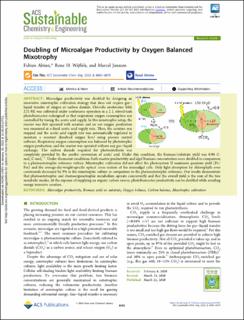| dc.contributor.author | Abiusi, Fabian | |
| dc.contributor.author | Wijffels, Rene Hubertus | |
| dc.contributor.author | Janssen, Marcel | |
| dc.date.accessioned | 2021-03-04T14:38:45Z | |
| dc.date.available | 2021-03-04T14:38:45Z | |
| dc.date.created | 2021-01-07T14:42:20Z | |
| dc.date.issued | 2020 | |
| dc.identifier.citation | Abiusi, F., Wijffels, R. H. & Janssen, M. (2020). Doubling of Microalgae Productivity by Oxygen Balanced Mixotrophy. ACS Sustainable Chemistry and Engineering, 8(15), 6065–6074. doi: | en_US |
| dc.identifier.issn | 2168-0485 | |
| dc.identifier.uri | https://hdl.handle.net/11250/2731714 | |
| dc.description.abstract | Microalgae productivity was doubled by designing an innovative mixotrophic cultivation strategy that does not require gas–liquid transfer of oxygen or carbon dioxide. Chlorella sorokiniana SAG 211/8K was cultivated under continuous operation in a 2 L stirred-tank photobioreactor redesigned so that respiratory oxygen consumption was controlled by tuning the acetic acid supply. In this mixotrophic setup, the reactor was first operated with aeration and no net oxygen production was measured at a fixed acetic acid supply rate. Then, the aeration was stopped and the acetic acid supply rate was automatically regulated to maintain a constant dissolved oxygen level using process control software. Respiratory oxygen consumption was balanced by phototrophic oxygen production, and the reactor was operated without any gas–liquid exchange. The carbon dioxide required for photosynthesis was completely provided by the aerobic conversion of acetic acid. Under this condition, the biomass/substrate yield was 0.94 C-molx·C-molS–1. Under chemostat conditions, both reactor productivity and algal biomass concentration were doubled in comparison to a photoautotrophic reference culture. Mixotrophic cultivation did not affect the photosystem II maximum quantum yield (Fv/Fm) and the average-dry-weight-specific optical cross section of the microalgal cells. Only light absorption by chlorophylls over carotenoids decreased by 9% in the mixotrophic culture in comparison to the photoautotrophic reference. Our results demonstrate that photoautotrophic and chemoorganotrophic metabolism operate concurrently and that the overall yield is the sum of the two metabolic modes. At the expense of supplying an organic carbon source, photobioreactor productivity can be doubled while avoiding energy intensive aeration. | en_US |
| dc.language.iso | eng | en_US |
| dc.publisher | ACS | en_US |
| dc.rights | Attribution-NonCommercial-NoDerivatives 4.0 Internasjonal | * |
| dc.rights.uri | http://creativecommons.org/licenses/by-nc-nd/4.0/deed.no | * |
| dc.title | Doubling of Microalgae Productivity by Oxygen Balanced Mixotrophy | en_US |
| dc.type | Peer reviewed | en_US |
| dc.type | Journal article | en_US |
| dc.description.version | publishedVersion | en_US |
| dc.rights.holder | © 2020 American Chemical Society | en_US |
| dc.subject.nsi | VDP::Matematikk og Naturvitenskap: 400 | en_US |
| dc.subject.nsi | VDP::Matematikk og Naturvitenskap: 400::Basale biofag: 470 | en_US |
| dc.subject.nsi | VDP::Teknologi: 500::Kjemisk teknologi: 560 | en_US |
| dc.source.pagenumber | 6065-6074 | en_US |
| dc.source.volume | 8 | en_US |
| dc.source.journal | ACS Sustainable Chemistry and Engineering | en_US |
| dc.source.issue | 15 | en_US |
| dc.identifier.doi | 10.1021/acssuschemeng.0c00990 | |
| dc.identifier.cristin | 1867180 | |
| dc.description.localcode | Paid Open Access | en_US |

